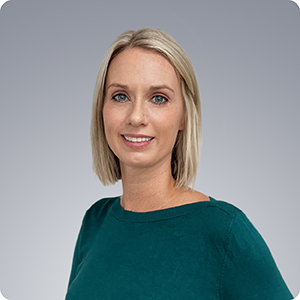The Everyday Business of Health Tech Operations
Unfiltered Perspectives
A Conversation on Holistic Revenue Operations in Healthcare Technology
Smile Interview Series: featuring Erin Prymas by Aarti Mathur
Date: December 12, 2023
Chief Revenue Officer (CRO)
Erin has over 20 years of experience in sales leadership, go-to-market strategy, healthcare technology operations and novel healthcare delivery systems. She has built, scaled and led multiple teams that solve customer requirements and accelerate revenue growth. As Smile's CRO, Erin is the master of operations, balancing rigor and experimentation to drive excellence. Her wealth of experience and leadership acumen make her an instrumental force in steering Smile towards operational excellence and continued success in the dynamic landscape of healthcare and technology. Erin spends her summers outdoors and winters with a book by the fire.
In today’s business environment, how do you stay true to your company’s vision, be nimble, operate with refined processes, and delight customers? Read how our Chief Revenue Officer, Erin Prymas manages it all for insights you can use in your business operations.
In this fifth release of our Thought Leadership Series, our Erin shares her holistic perspective on the role and how she achieves balance in her portfolio and her workday.
AM: When I think of a CRO I think of growth and sales targets. In your ~18 months here at Smile, you have massively expanded how I think of this role. Tell me about your career background and what this role is all about?
EP: In some organizations, the CRO is a Head of sales or Head of Growth role that is focused primarily on winning new business. However, there are many things in an organization that impact revenue, so I approach my role with a broader lens. Of course, sales and new business is a huge part of what I do, but my job is to drive alignment across the revenue generating functions at Smile—that includes sales, partnerships, marketing, sales engineering, customer success, pricing, and revenue operations. It also includes working with other teams, such as product and delivery, to ensure we are meeting our customers needs with our current products and our future ones. That requires me to think about not only “what gets the deal done”, but also how we keep our customers happy long term, and what delivers a great customer experience.
Fortunately, I have had a wide range of career experiences that I pull from on a daily basis. I trained as a salesperson early in my career, refined that skill over time, and built go-to-market sales models that scaled and re-imagined teams. I have also been on the delivery side of large programs, delivered customer-facing quality programs, and I even spent a few years in finance! All of that helps me navigate the nuances of generating long term, repeatable revenue strategies for an organization.
AM: That is quite the range! Applying these experiences and perspectives to larger, multinational companies is different compared to a smaller health IT start-up like Smile. Could you speak to that?
EP: I’ve always been drawn to healthcare, starting in University, and most of my roles have been healthcare focused. I spent 9 years at GE Healthcare and benefited from its very strong leadership training, and diverse career opportunities. It was the type of company where MBAs studied management practices, and I had the benefit of being a real life student of that. When it was time to go to another company, I wanted to go to one that was also being “studied” in that way. Amazon was an obvious choice for me. I had read so much about the Leadership Principles, narrative culture for decision making, and focus on the customer that I wanted to be a real time student of that too.
At AWS, I focused on experimenting with innovative go-to-market strategies in the US and Canada. I learned how to fail fast, scale things that work, look at everything through the lens of the customer, and then I got a chance to scale a new healthcare business called Amazon Care. I joined Care when it was a part of Amazon’s Grand Challenge (Amazon’s internal incubator), right before they were ready to scale the business and sell the service to other enterprises. About 18 months later, Amazon made a pivot with Amazon Care, and I had to help scale the business down. It was a failure in that it provided a great patient experience, but the actual customer (intermediaries such as payers and large enterprises that paid for the service) didn’t see the value. I learned that you have to consider every customer, not just the end customer, when you are bringing innovative things to market.
It was time to move on again, and I loved the start-up environment. I wanted another chance to work for an innovative healthcare company, and I wanted to take what I learned and pay it forward in a way. Smile was a perfect fit— great product, a notable customer base and a company that was looking to scale. When I met Smile’s CEO, Duncan Weatherston, he shared his vision about how Smile can impact patient care globally. I was familiar with the challenges of data interoperability in healthcare, but I hadn’t really considered the technological innovation required to make it happen. When I realized that Smile also maintained HAPI FHIR® (the open-source implementation of the HL7® FHIR standard) because of their belief in fostering innovation in addition to a great enterprise grade offering, I was hooked! I made the decision to join Smile, help them grow and deliver #BetterGlobalHealth.
AM: These last few years (lockdowns and the world after) have been rough on the economy in general, and certainly growth and revenue in the tech world have been impacted. How have they impacted your perspective, role, motivations and goals?
EP: Many assume that face-to-face sales meetings are dead and that we are now in a Google Meet/ Zoom/MS Teams world. I think face-to-face meetings have become even more important. We can certainly cover more ground in a day by stacking up meeting after meeting and eliminating travel time, but the most impactful customer meetings I have are still face-to-face. To navigate this new world, we need to find a balance. Customer relationships are vital to a business, and we need to make an investment in developing and taking advantage of the flexibility that virtual connections offer. We must pay more attention to non-verbal cues, and focus on clear communication because meetings are shorter and distractions come from all directions with email, phone, and Slack/Teams messages. With customer conversations and the current economic climate specifically, there is far more scrutiny on organizational technology purchases, so the ROI has to be made very clear early on.
Additionally, having virtual-first teams provides both opportunities and challenges. Virtual-first companies aren’t limited by geography, and can hire the best talent for the role regardless of location. However, when teams are dispersed, it is harder to collaborate. A 10-minute ‘hallway conversation’ becomes a 30-minute meeting slot that has to be pre-booked. I try to balance making myself available for more ‘virtual hallway conversations’ to ensure we’re staying connected and moving quickly with efficient pre-planned meetings where we can make the best use of everyone’s valuable time.
AM: Over the last few months you’ve traveled to Australia and Indonesia as their health data transformation needs are emerging on the world stage. From your perspective, how are these markets different from North America, and how does that impact your portfolio at Smile?
EP: All three of those markets are different, and as a result, Smile’s role is also different. However, I did find an unexpected similarity where Smile is very well positioned to help—the International Patient Summary (IPS). The IPS is an international effort to develop a standard extract of a patient record, supported in FHIR through the IPS Implementation Guide (IG). With this, when a patient crosses healthcare borders (across a state or country), they have a standard way of displaying their healthcare information if they need care outside of their primary location. Here is why that matters:
More than 85% of Indonesians identify as Muslim. As such, between one and two hundred thousand Indonesian pilgrims travel to Mecca in Saudi Arabia for Hajj every year. It’s hot, dry and crowded; resulting in many pilgrims requiring unexpected medical care. Smile is now working on a proof of concept with the Indonesian Digital Transformation Office on how to implement the IPS for pilgrims. The health data infrastructure is still maturing in Indonesia—they aren’t burdened by technical debt, can innovate without worrying about modernizing old technology, and are mandating FHIR from the outset.
Australia and New Zealand have a reciprocal relationship where citizens of each country are free to live, work, and travel in the other, with almost 1 million traveling back and forth each year. As a result of this, they are also looking to the IPS as a potential solution to solve the cross border healthcare information needs of their citizens. Australia is in the process of establishing an AU Core Implementation Guide for FHIR in the Australian Context, while New Zealand established an NZ Core IG in 2020, so they are primed to be able to take advantage of what an IPS can offer.
Canada and the United States are different. Decades of legacy healthcare infrastructure persist across the countries, and that makes connecting healthcare data an exceptional challenge. Smile plays a different role for our customers here. We help them think through their modernization strategy, so that they can future proof their tech stack. We meet our customers where they are, and support them in the way that works best for them—that may mean replacing existing tech or augmenting their existing tech.
AM: A lot has changed in healthcare, in tech, and in leadership over the course of your career. Could you share with us how you have evolved as a Woman in Leadership and what advice you would give to someone just starting their career in this field?
EP: I had lots of early mentorship support that helped me identify new ways I could lead, and contribute to my company and my customers. Without those early mentors, I think my career trajectory might have been very different. As my career progresses, I look for ways to give back to others in similar ways. Some key pieces of advice I’ve gathered from my mentors over the years are:
-
There is no linear career path. I moved from leadership roles with 100+ team members to an individual contributor (IC) role. My advice is to be thoughtful about what you seek to learn in each new role. If it’s a new industry and a new company, maybe an IC role where you can build your own personal expertise before you’re responsible for the coaching and development of others is the right step. Focus on building both depth and breadth of experience, and exciting opportunities will find you.
-
Look for roles and companies where you have lots to learn, can do interesting work, and can learn from great leadership. If you have the opportunity to be in situations where you are challenged with solving complicated problems, you can experience personal growth along with professional growth.
-
Be intentional about investing in your network. I’ve worked with so many brilliant and successful people. I keep in contact with 15-20 people that I’ve worked with over the years on a regular basis (and more on an ad hoc basis). Many of my former co-workers are still in healthcare, and I love learning about how they adapt to challenges in their companies as well as learning more about their customers and what is important to them. It’s impossible to keep up with everyone, but pick a few that you want to be intentional about keeping in touch with.
AM: As CRO you travel a lot and have to balance both strategic and operational efforts. Since you’ve joined you’ve refined a lot of our processes and yet you still make time to connect with each of us on the team, complete reviews and approvals and provide direction. What kind of processes, practices, or mind-set enable you to do all of this and more?
EP: My calendar is very full, so I plan out how I want to allocate my time and set expectations for meetings to make the best use of everyone’s time. First, I want to know if the purpose of a meeting is for a decision, to inform, or to solicit input. There are different requirements for each type of meeting. If the meeting is with a customer, I would need to understand what we want to accomplish in order to ensure that we have a prep call with the appropriate attendees. If there are multiple organizational layers in attendance, do we all need to be there? Why is that? Does the team need guidance to make a decision in my absence?
I try to tackle tougher topics in the morning. I'm an early riser. I typically start at 7am because much of my team is Eastern Time zone based (I am Central), and after 3pm I start to experience decision fatigue. I get so much more done if I structure my days in a way that allows me to tackle the harder topics earlier in the day. Also, I find context switching is hard. So I try to group the same types of meetings together on any given day—like keeping 1:1s together, grouping information sharing, and team meetings together. I make sure to give myself little breaks to check emails, slack, etc. This allows me to be more productive during the work day.
Finally, my calendar is color coded with different types of meetings associated with different colors, so I can easily see what my day and week looks like. I regularly do a calendar audit to make sure I am spending my time where I think it is most needed. I love the feature in Google calendar to do this! I try to save about 15% of my week for strategy/thinking time, and then I typically spend 20-25% in 1:1 conversations via 1:1 meetings with my team; about 15-20% in meetings with customers or partners; 30% in standing meetings, and the rest is for ad hoc needs. When things feel like they’re heavy in one area or another, I do a quick check to understand if I need to make adjustments and why that might be.
This may not work for everyone, but I’ve been operating this way for almost 10 years and it works for me!
AM: These are great insights! You mentioned giving back for the mentorship you received and this is a prime example of how you're doing just this. We appreciate it!
More Unfiltered Perspectives from Smile’s Thought Leaders is available here:






.png?width=150&height=150&name=Untitled%20design%20(2).png)